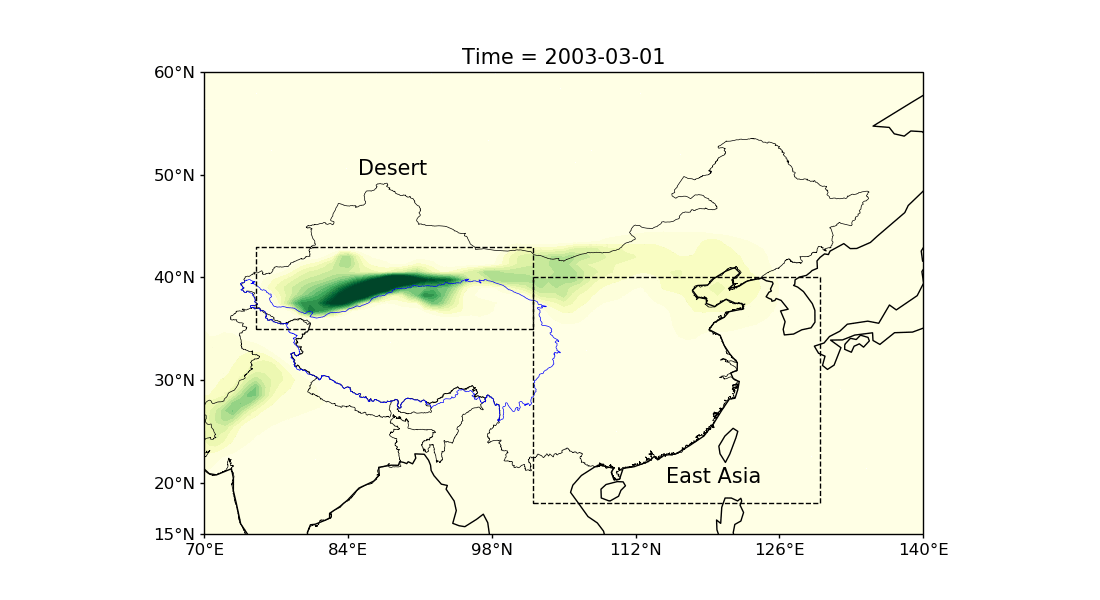By: Dhirendra Kumar
Mineral dust plays an important role in the earth system due to its interaction with climate, ecosystems, biogeochemical cycles, and human society in direct and indirect ways [1,2,3]. Their interactions with the weather and climate occur at multiple spatial and temporal scales. While dust aerosols affect the radiation budget by absorbing, reflecting, and scattering the incoming solar and outgoing terrestrial radiation, they can have many more indirect consequences in terms of modification of the cloud microphysical properties to changes in the hydrological cycles. These mineral dust aerosols mostly originate over the semi-arid to arid regions of the world such as Northern Africa, Arabian Peninsula, Southwest Asia, and northern Chinese region in the northern hemisphere [4]. In terms of the direct impacts of dust, it affects the visibility and air quality over downstream regions where dust is transported towards, thus affecting the well-being of the exposed population.

Figure 1: Atmospheric haze over Beijing during a recent massive dust storm on 15 Mar 2021.
The extreme episodes of dust over the East Asian region are very frequent and affect the major cities in China, Japan, South Korea, and far east regions. With the highest frequency during the spring season, the individual events may occur and persist for 2-3 days at least and have a wide range of impacts in the day-to-day life of large populations. A recent massive dust storm during March 2021 is a recent examples (Fig. 1) when compounded by the hot and dry conditions and heavy north-westerly winds, the Beijing skies experienced one of the worst air quality episodes in a decade [5].
Using a combination of the state-of-the-art CAMS (Copernicus Atmospheric Monitoring Service) reanalysis [6] which includes information on dust aerosols, as well as high-resolution climate model simulations, we are trying to understand the characteristics of these dust storms and their associated meteorological drivers. Based on case studies of extreme dust episodes, we try to understand the contrasting meteorological drivers for different cases having impacts over different regions. We find that extreme dust emission episodes originate over the Gobi and inner Mongolian deserts resulting in high dust aerosol load over the adjacent regions such as the Taklamakan desert, Gobi Desert, Beijing, and other far Eastern areas due to different transport conditions. An animation showing impacts in terms of high dust AOD (Aerosol Optical Depth) values over the larger East Asian region is shown in Fig. 2. The dust can also reach up to the southern parts of the Chinese territory and thus engulfs major cities including Beijing, Shanghai, and Nanjing. Figure 2: Daily variation of Dust Aerosol Optical Depth over the East Asia region during the spring from the CAMS dataset.
Figure 2: Daily variation of Dust Aerosol Optical Depth over the East Asia region during the spring from the CAMS dataset.
We also look at the large-scale meteorological conditions during these events using the reanalysis as well as the model simulations. We find that the high-resolution model can resolve the major characteristics of these dust storms and provide greater insights about the spatial structure of the dust emissions and associated impacts over the region. The models also accurately represent the large-scale meteorological drivers such as the surface and low-level circulations, and the synoptic conditions. Although the models can efficiently resolve the broad-scale features during extreme dust episodes, they have inherent systematic errors, as they overestimate the dust emission while underestimating the AOD values.
The experiences gained from such investigations provide further avenues for understanding the extreme dust cycle, its behaviour, and complex interactions within the climate system from the perspective of climate change. In addition, it also highlights the strengths and weaknesses of the model outlining the need for further improvements in the representation of processes related to mineral dust emission and transport.
